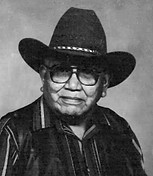

Lakota Cultural Center


Sidney Keith
Minnecoujou
Hunkpapa
THE SWEATLODGE
An honored elder guides the inikagapi (sweat), usually in the evening twilight. Unless in preparation for the sundance, then it is performed also in the morning, culminating just prior to sunrise. The painting recalls perfectly the surrealistic relationships. In the night-scene, the water poured from the buffalo horn cup splashes onto the red hot stones transforming the heat of the stones of the flames to steam. Purification in all ways is the intent of this ritual, done in Lakota prayers with the sacred pipe, here shown with the stem pointed towards the heavens, where the prominent full moon and the delicate stars are in luminous splendor. And within the iniyuktan, canopied tent, the temperature easily reaches the boiling point or above at the center point of the rocks and the splashing water. Spiritually intent on redemption, the four figures aspire to a supernatural stance, sensually focused by the heat albeit some experiences only a physical cleansing and a slight change of attitude, but nevertheless, changing for a better life. An eagle, ghost like, flares to a slow-down about to land lightly on the canopy of the steam bath. The realism is shown by: the flames...the pipe...the deer-horn fork...the stones...the buffalo-horn cup and the water...the moon and stars. The surrealism by: the other-worldly sky and landscape...the ghostly eagle...the striped configuration of the four steam-bathers, each a different color.
The analysis of the origin and meaning of the inikagapi must include digging into the morpheme and maybe into the fire-pit level of the linguistic unity, inikagapi can be broken into shorter parts: ini=to live; kaga=make; pi=they. Or in English words order, it would translate - they create to live. As legend, there is a story of how a boy of stone was born to a virgin who had swallowed a stone. Of how he rescued four uncles, out of an expedition, captured by a wicked old lady. Of how he revived them from near death as prisoners. Of how, he did the first inikagapi - one of the seven most important rituals of the Lakota ceremonials. And this may be more rightly renamed and titled "The Life Renewal Ceremony.
National Forests were established by law, "to furnish a continuous supply of timber for the use and necessities of the citizens of the United States and to improve and protect the forest, securing favorable conditions of water flows." Eighty percent of our National Forest lands are managed under the Multiple-Use Sustained Yield Act of 1960 for multiple benefits including wood fiber, forage, wildlife, water and recreation. The other twenty percent of National Forest lands are managed by the Wilderness Act of 1964 and are excluded from active management.